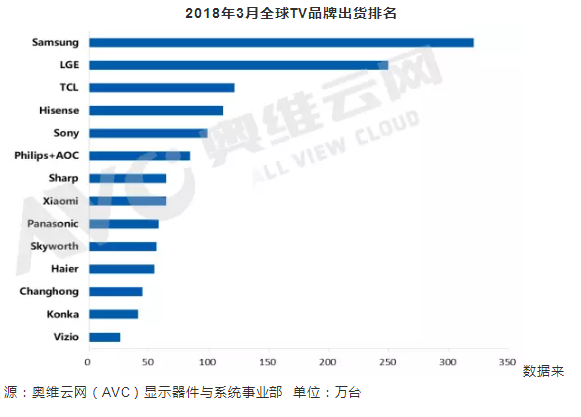For the color TV industry, the March transcript is undoubtedly satisfactory. AVC released the "Global TV Brand Shipment Monthly Data Report" showing that in March 2018, the global television brand shipped 17.32 million units, a year-on-year increase of 6%. Judging from the performance of various brands, Samsung still maintains its dominant position in the industry. In March, it shipped 3.2 million units. In the first quarter, it shipped a total of 9.37 million units, which was basically the same as last year. In terms of product structure, Samsung’s share of more than 48 inches increased by 6 percentage points compared to the same period last year; and the second-ranked LG’s shipments in March was 2.71 million units, and cumulative shipments in the first quarter totaled 6.66 million units. This was a slight increase of 1% over the same period. High-end OLEDs shipped 150,000 units in March, a year-on-year increase of 121%. The third place came from China's color TV giant TCL. In March, its sub-brands shipped a total of 1.21 million units, an increase of 3% year-on-year in March. North America continued to grow and Latin America pre-stocked the World Cup. In the first quarter, the TCL brand (including Thomson, etc.) shipped 2.34 million units overseas, which was a 52% increase year-on-year, and was catching up with Samsung and LG with strong growth momentum. The fourth place is Hisense, which also came from China. In March, it contained 1.12 million units of North American Sharp's worldwide shipments, a year-on-year increase of 28.5%. Hisense shipped more than 2 million units in China in the first quarter, a year-on-year increase of 23%, and its growth momentum is not to be underestimated. Japan's color TV giant Sony took fifth place. It shipped 990,000 units worldwide and shipped 2.65 million units in the first quarter, an increase of 22% year-on-year. Among them, OLED shipments of 65K have continued to increase in high-end market share in North America and China, which has attracted industry attention. After the ranking was Philips + AOC series, shipments continued to grow. In March, a total of 845,000 units were shipped. The AOC brand continued its efforts in the Latin American market. It shipped 540,000 units in the first quarter, an increase of 275% year-on-year. Among them, Philips' high-end product OLED sales grew rapidly. In the first quarter, the 55-inch Philips OLED shipped 25,000 units. From the perspective of the industry, the overall growth momentum of OLED is fairly good. Among several other brands, several brands from China have also performed well: Skyworth's shipments in the first quarter increased by 12% year-on-year, and Konka's shipments increased by 6% in the first quarter. Changhong's shipments grew by 2% in the first quarter, and achieved certain growth under the overall sluggish environment. This is also a reflection of hard power. It is worth mentioning that Xiaomi, with its cost-effective advantage, performed very well both domestically and internationally in March: With the rice flour festival in the Chinese market, it shipped 550,000 units domestically, ranking second in China in shipments in a single month; Overseas, Xiaomi TV started selling in India in February. In the first quarter, India shipped more than 100,000 units, and its main sizes were 32, 43, and 55 inches. So why did the color TV market rebound in March? In this regard, industry analysts believe that: In addition to entering the TV sales season, and the World Cup to stimulate consumer TVs, the upstream panel began to decline for the color TV industry to release new production capacity. As we all know, the panel price occupies a large proportion in the total cost of the TV, and the shrinking of the panel price will reduce the pressure on the TV manufacturers. This may mean that the TV industry, which has maintained a downward trend due to the increase in panel prices, has finally come to an end.
IDC D-sub Connectors
IDC (insulation displacement contact) D-sub connectors are a type of electrical connectorthat's designed to be connected to the conductor(s) of an insulated cable, most commonly a ribbon cable(a cable with many conducting wires running parallel to each other on the same flat plane).
Applications for IDC D-sub connectors
IDC D-sub connectors, attached to ribbon cables, are helpful in situations where you need to make a lot of connections without a big number of wires. They're commonly used in computer and electronic systems that require multiple data buses to link internal peripherals, such as disk drives to their drive controllers. They're also frequently used in industrial and telecom applications.
How does an IDC D-sub connector work?
With an IDC D-sub connector, there's no need for cable preparation – in other words, you don't need the strip the cables of their insulation before connecting. To connect the cable to the connector, there are sharpened blades (or contacts) on the connector that force through the insulation around the cable, making a secure connection.
IDC D sub connector from Antenk, Outstanding features high contact reliability, long life and low contact resistance.
Low Profile IDC D-Sub Connectors,Flat Cable IDC D-Sub Connectors,D Sub Connector IDC Type,IDC D-Sub Standard Connectors ShenZhen Antenk Electronics Co,Ltd , https://www.antenk.com
March 31, 2023